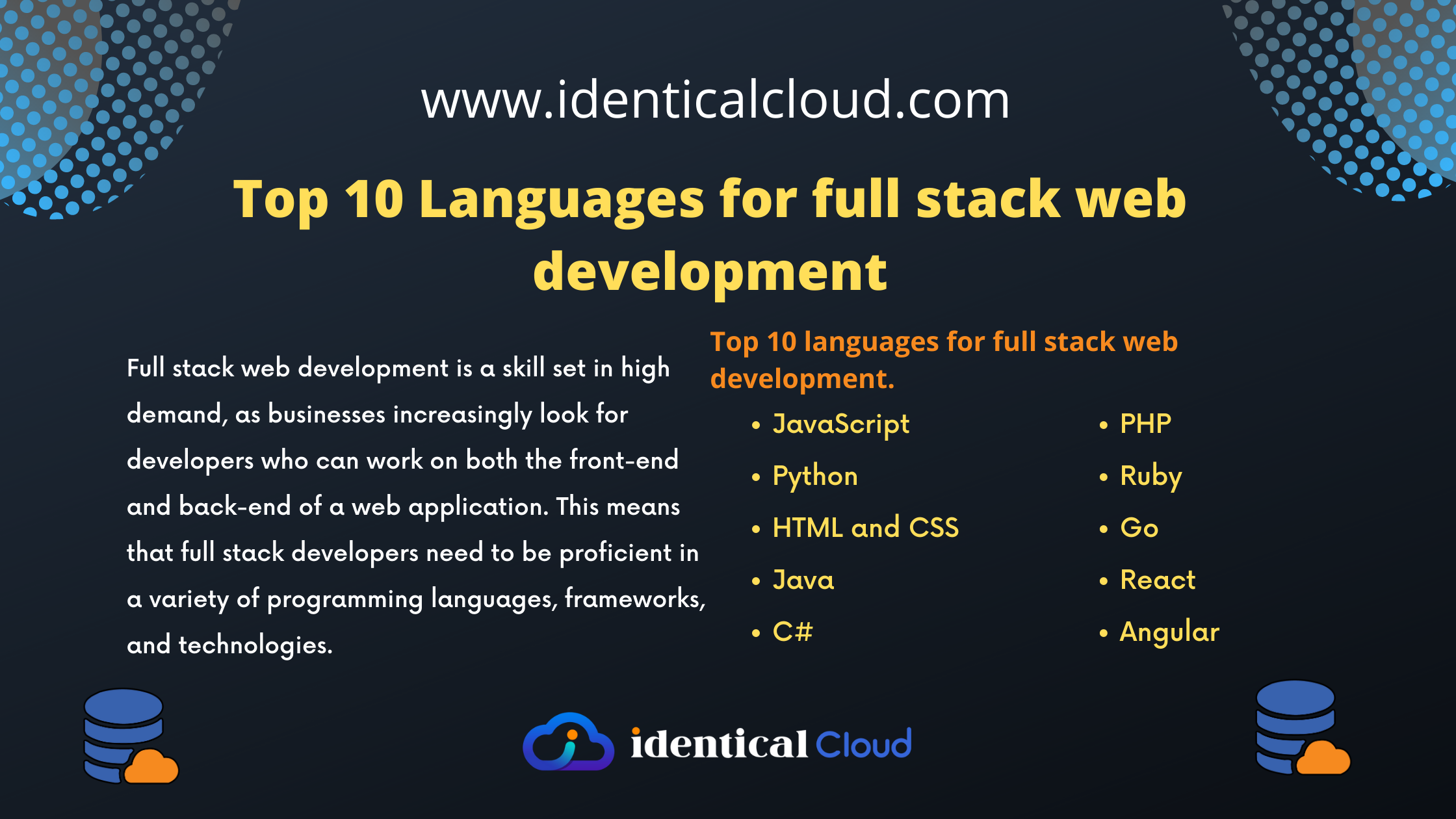
Top 10 Languages for full stack web development
Top 10 Languages for full stack web development
Full stack web development is a skill set in high demand, as businesses increasingly look for developers who can work on both the front-end and back-end of a web application. This means that full stack developers need to be proficient in a variety of programming languages, frameworks, and technologies.
In this blog post, we will discuss the top 10 languages for full stack web development in 2023. We will also provide a brief overview of each language, as well as some of the benefits of learning it.
1. JavaScript
JavaScript is a programming language that is one of the core technologies of the World Wide Web, alongside HTML and CSS. As of 2023, 98.7% of websites use JavaScript on the client side for webpage behavior, often incorporating third-party libraries.
JavaScript is a high-level, often just-in-time compiled language that conforms to the ECMAScript standard. It has dynamic typing, prototype-based object-orientation, and first-class functions. It is multi-paradigm, supporting event-driven, functional, and imperative programming styles. It has application programming interfaces (APIs) for working with text, dates, regular expressions, standard data structures, and the Document Object Model (DOM).
JavaScript is a versatile language that can be used for a variety of tasks, including:
- Creating interactive web pages
- Processing form data
- Sending and receiving ajax requests
- Creating games and animations
- Building web applications
JavaScript is a popular language for web development because it is easy to learn and use. It is also a very powerful language that can be used to create complex applications.
If you are interested in learning JavaScript, there are many resources available online and in libraries. There are also many online courses and tutorials that can teach you the basics of JavaScript.
Once you have learned the basics of JavaScript, you can start practicing by creating your own web pages and applications. There are many JavaScript frameworks and libraries available that can help you build complex applications.
JavaScript is a powerful language that can be used to create a wide variety of web applications. If you are interested in web development, JavaScript is a language that you should definitely learn.
Here are some of the benefits of learning JavaScript:
- JavaScript is a popular language, so there are many resources available to help you learn it.
- JavaScript is a versatile language that can be used for a variety of tasks.
- JavaScript is a powerful language that can be used to create complex applications.
- JavaScript is a relatively easy language to learn, even for beginners.
2. Python
Python is a general-purpose, high-level programming language. Its design philosophy emphasizes code readability with its notable use of significant whitespace. Its language constructs and object-oriented approach aim to help programmers write clear, logical code for small and large-scale projects.
Python is dynamically typed and garbage-collected. It supports multiple programming paradigms, including structured (particularly procedural), object-oriented, and functional programming. It is often described as a “batteries included” language due to its comprehensive standard library.
Python is used for a wide variety of tasks, including:
- Web development
- Data science
- Machine learning
- Artificial intelligence
- Scientific computing
- Software development
Python is a popular language for beginners because it is easy to learn and use. It is also a powerful language that can be used to create complex applications.
Here are some of the benefits of learning Python:
- Python is a popular language, so there are many resources available to help you learn it.
- Python is a versatile language that can be used for a variety of tasks.
- Python is a powerful language that can be used to create complex applications.
- Python is a relatively easy language to learn, even for beginners.
3. HTML (HyperText Markup Language) and CSS (Cascading Style Sheets)
HTML (HyperText Markup Language) and CSS (Cascading Style Sheets) are the two most important languages for web development. HTML is used to create the structure of a web page, while CSS is used to style the appearance of a web page.
HTML is a markup language, which means that it uses tags to define the structure of a web page. Tags are enclosed in angle brackets, such as <h1> and <p>. The <h1> tag defines a heading, while the <p> tag defines a paragraph.
CSS is a stylesheet language, which means that it uses rules to define the appearance of a web page. Rules are made up of selectors and declarations. The selector identifies the element that the rule applies to, while the declaration specifies the property and value of the style.
For example, the following CSS rule would set the font size of all <h1> elements to 24px:
h1 {
font-size: 24px;
}
HTML and CSS are essential for creating web pages. By learning these languages, you can create web pages that are both informative and visually appealing.
Here are some of the benefits of learning HTML and CSS:
- HTML and CSS are relatively easy to learn, even for beginners.
- There are many resources available to help you learn HTML and CSS, including online tutorials, books, and courses.
- HTML and CSS are used by almost every website on the internet, so there is a high demand for developers who know these languages.
- HTML and CSS are essential for creating web pages that are both informative and visually appealing.
4. Java
Java is a general-purpose, object-oriented programming language that is used for a wide variety of tasks, including web development, desktop development, and mobile development. Java is a powerful language that can be used to create complex applications.
Java is a compiled language, which means that it is converted into machine code before it is executed. This makes Java programs faster than interpreted languages, such as JavaScript. Java is also a platform-independent language, which means that Java programs can be run on any platform that has a Java Virtual Machine (JVM).
Java is a relatively easy language to learn, even for beginners. It has a simple syntax that is similar to other popular programming languages, such as C++ and C#. Java also has a large community of developers and a wealth of resources available to help you learn the language.
If you are interested in learning Java, there are many resources available online and in libraries. There are also many online courses and tutorials that can teach you the basics of Java.
Once you have learned the basics of Java, you can start practicing by creating your own applications. There are many Java frameworks and libraries available that can help you build complex applications.
Here are some of the benefits of learning Java:
- Java is a popular language, so there are many resources available to help you learn it.
- Java is a versatile language that can be used for a variety of tasks.
- Java is a powerful language that can be used to create complex applications.
- Java is a relatively easy language to learn, even for beginners.
5. C#
C# is a general-purpose, object-oriented programming language that was developed by Microsoft in 2000. It is a compiled language, which means that it is converted into machine code before it is executed. C# is a powerful language that can be used to create a wide variety of applications, including web applications, desktop applications, and mobile applications.
C# is a versatile language that can be used for a variety of tasks. Here are some of the things that C# can be used for:
- Web development: C# is a popular language for web development. It can be used to create both server-side and client-side applications.
- Desktop development: C# can be used to create desktop applications that run on Windows, macOS, and Linux.
- Mobile development: C# can be used to create mobile applications that run on iOS and Android.
- Game development: C# is a popular language for game development. It can be used to create both 2D and 3D games.
- Enterprise development: C# is a popular language for enterprise development. It can be used to create applications that are used in businesses.
C# is a relatively easy language to learn, even for beginners. It has a simple syntax that is similar to other popular programming languages, such as Java and C++. C# also has a large community of developers and a wealth of resources available to help you learn the language.
If you are interested in learning C#, there are many resources available online and in libraries. There are also many online courses and tutorials that can teach you the basics of C#.
Once you have learned the basics of C#, you can start practicing by creating your own applications. There are many C# frameworks and libraries available that can help you build complex applications.
C# is a powerful and versatile programming language that can be used to create a wide variety of applications. If you are interested in programming, C# is a language that you should definitely learn.
Here are some of the benefits of learning C#:
- C# is a popular language, so there are many resources available to help you learn it.
- C# is a versatile language that can be used for a variety of tasks.
- C# is a powerful language that can be used to create complex applications.
- C# is a relatively easy language to learn, even for beginners.
6. PHP
PHP is a server-side scripting language that is used for web development. PHP is a powerful language that can be used to create dynamic and interactive web pages.
PHP is a relatively easy language to learn, even for beginners. It has a simple syntax that is similar to other popular programming languages, such as C and Java. PHP also has a large community of developers and a wealth of resources available to help you learn the language.
If you are interested in learning PHP, there are many resources available online and in libraries. There are also many online courses and tutorials that can teach you the basics of PHP.
Once you have learned the basics of PHP, you can start practicing by creating your own web pages. There are many PHP frameworks and libraries available that can help you build complex web applications.
Here are some of the benefits of learning PHP:
- PHP is a popular language, so there are many resources available to help you learn it.
- PHP is a versatile language that can be used for a variety of tasks.
- PHP is a powerful language that can be used to create dynamic and interactive web pages.
- PHP is a relatively easy language to learn, even for beginners.
7. Ruby
Ruby is a general-purpose, object-oriented programming language that was developed by Yukihiro “Matz” Matsumoto in Japan in 1995. Ruby is known for its elegant syntax and its powerful libraries. Ruby is also a very popular language for web development, and it is used by some of the largest companies in the world, such as Airbnb, GitHub, and Shopify.
Ruby is a dynamically typed, object-oriented programming language that is known for its elegant syntax and its powerful libraries. Ruby is also a very popular language for web development, and it is used by some of the largest companies in the world, such as Airbnb, GitHub, and Shopify.
Ruby is a powerful and versatile language that can be used to create a wide variety of applications. Some of the most popular uses of Ruby include:
- Web development
- Data science
- Machine learning
- Artificial intelligence
- Scientific computing
- Software development
Ruby is a relatively easy language to learn, even for beginners. It has a simple syntax that is similar to other popular programming languages, such as Python and JavaScript. Ruby also has a large community of developers and a wealth of resources available to help you learn the language.
Here are some of the benefits of learning Ruby:
- Ruby is a popular language, so there are many resources available to help you learn it.
- Ruby is a versatile language that can be used for a variety of tasks.
- Ruby is a powerful language that can be used to create complex applications.
- Ruby is a relatively easy language to learn, even for beginners.
If you are interested in learning Ruby, there are many resources available online and in libraries. There are also many online courses and tutorials that can teach you the basics of Ruby.
8. Go
Go is a compiled, statically typed programming language developed by Google in 2009. It is a general-purpose language that can be used for a wide variety of tasks, including web development, system programming, and distributed systems.
Go is a relatively new language, but it has quickly become popular due to its simplicity, performance, and concurrency features. Go is also a very expressive language, which means that it can be used to write clear and concise code.
Here are some of the benefits of learning Go:
- Go is a popular language, so there are many resources available to help you learn it.
- Go is a versatile language that can be used for a variety of tasks.
- Go is a powerful language that can be used to create complex applications.
- Go is a relatively easy language to learn, even for beginners.
If you are interested in learning Go, there are many resources available online and in libraries. There are also many online courses and tutorials that can teach you the basics of Go.
9. React
ReactJS is a JavaScript library for building user interfaces. It is a declarative library, which means that you describe what you want the UI to look like, and React figures out how to make it happen. ReactJS is also a component-based library, which means that you can break your UI down into smaller, reusable components.
ReactJS is a popular library for building web applications. It is used by some of the largest companies in the world, such as Facebook, Instagram, and Netflix. ReactJS is also a popular library for building mobile applications.
Here are some of the benefits of using ReactJS:
- Declarative: ReactJS is a declarative library, which means that you describe what you want the UI to look like, and React figures out how to make it happen. This makes ReactJS code easier to read and understand.
- Component-based: ReactJS is a component-based library, which means that you can break your UI down into smaller, reusable components. This makes ReactJS code easier to maintain and update.
- Performance: ReactJS is a very performant library. This is because ReactJS only renders the parts of the UI that need to be rendered.
- Popular: ReactJS is a very popular library. This means that there are a lot of resources available to help you learn ReactJS, and there is a large community of developers who can help you if you get stuck.
If you are interested in learning ReactJS, there are many resources available online and in libraries. There are also many online courses and tutorials that can teach you the basics of ReactJS.
Once you have learned the basics of ReactJS, you can start practicing by creating your own applications. There are many ReactJS frameworks and libraries available that can help you build complex applications.
10. Angular
AngularJS is a JavaScript framework developed and maintained by Google. It is a structural framework for dynamic web applications. AngularJS is based on MVC (Model View Controller) architecture.
AngularJS is a popular framework for building web applications. It is used by some of the largest companies in the world, such as Google, Forbes, and PayPal. AngularJS is also a popular framework for building mobile applications.
Here are some of the benefits of using AngularJS:
- MVC architecture: AngularJS is based on MVC architecture, which makes it easy to structure your code and keep it organized.
- Dependency injection: AngularJS uses dependency injection, which allows you to decouple your code and make it easier to test.
- Data binding: AngularJS provides data binding, which allows you to bind data to your UI elements so that they update automatically when the data changes.
- Routing: AngularJS provides routing, which allows you to navigate between different pages in your application.
- Forms: AngularJS provides forms, which allows you to create and validate forms in your application.
If you are interested in learning AngularJS, there are many resources available online and in libraries. There are also many online courses and tutorials that can teach you the basics of AngularJS.
Once you have learned the basics of AngularJS, you can start practicing by creating your own applications. There are many AngularJS frameworks and libraries available that can help you build complex applications.
These are just a few of the top languages for full stack web development in 2023. The best language for you will depend on your individual skills and interests. However, learning any of these languages will give you a solid foundation in full stack web development.
Full stack web development is a challenging but rewarding career path. By learning the top languages for full stack web development, you can increase your chances of landing a job in this growing field.
I hope you found this blog post helpful. If you have any questions, please feel free to leave a comment below.









